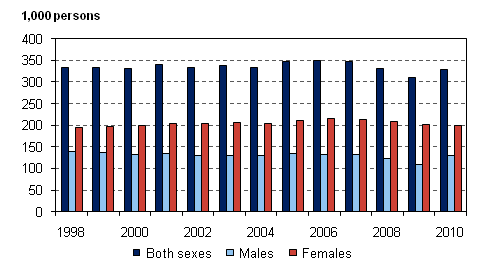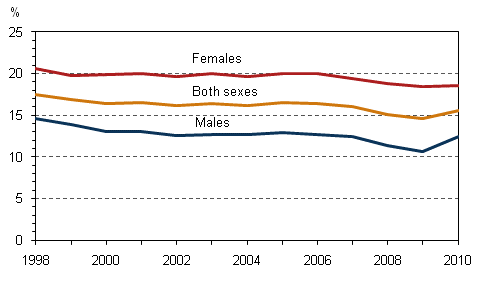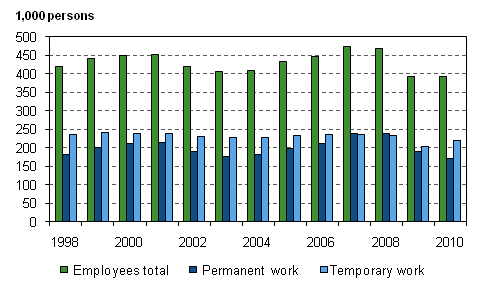1 Temporary employment relationships increased in 2010
1.1 One employee in six has a temporary employment contract
According to Statistics Finland's Labour Force Survey, in 2010 the average number of employees in Finland was 2,120,000, which was nearly the same as one year earlier. The employment situation of employees improved towards the end of 2010. At the same time, the number of employees with temporary employment contracts went up. In 2010, there were 329,000 temporary employees, which was 19,000 more than in the previous year (Figure 1). Approximately 16 per cent of employees had temporary employment contracts in 2010. The share rose by one percentage point from 2009. The share of temporary employees was still below the long-term average. (Figure 2.)
Figure 1. Number of temporary employees aged 15–74 by sex in 1998-2010

Temporary employment is more widespread among women than men. In 2010, 200,000 of all temporary employees were women and 129,000 men. The share of temporary employees was around 18 per cent among female employees and around 12 per cent among male employees. The number and share of temporary employment contracts rose among male employees in 2010. Among female employees, they remained on level with the year before. Temporary employment contracts increased mainly in the private sector (+15,000).
Figure 2. Share of temporary employees of all employees aged 15–74 by sex 1998-2010, %

Temporary employment shows clear seasonal variation, for the number of temporary employment contracts usually goes up in the second and third quarters of the year. In 2009, the decrease in temporary employment relationships seemed to occur especially in summer jobs. By contrast, in 2010 the growth in the number of temporary employment contracts from the respective time period of the year before started in the second quarter and continued through to the end of the year.
1.2 Two out of three temporary employees could not find permanent work
To an employee, temporary employment can be either a desired or involuntary form of employment. Approximately one-quarter of temporary employees did not want a permanent job. The majority of them were aged between 15 and 24. Summer workers are a typical group of persons working voluntarily in temporary jobs.
However, a more common reason for working in a temporary employment relationship is that permanent work cannot be found. In 2010, the lack of permanent work was the reason why around 64 per cent of temporary employees worked in temporary jobs. In 2010, there were 206,000 temporary employees on the labour market who had not found a permanent job even though they would have wanted one. Of them, 134,000 were women and 72,000 men. Involuntary working under temporary contracts increases with age.
The share of persons working involuntarily in temporary jobs among all temporary employees decreased slightly from 2009 to 2010.
1.3 Around one-half of new employment contracts were temporary
The number of new employment contracts of under one year's duration fell clearly from 2008 to 2009. In 2010, there were 393,000 new employment contracts, which is almost the same number as in 2009. Fifty-six per cent of the new employment contracts were temporary. The share was four percentage points higher than in 2009. (Figure 3.)
Figure 3. New employment contracts of under one year’s duration of employees aged 15–74 in 1998-2010

There is a clear difference between women and men in whether a new employment relationship is temporary or permanent. In 2010, approximately 62 per cent of women’s and around 49 per cent of men’s new employment relationships were temporary. The majority of men's new employment contracts have almost always been permanent since the year 1997 when a fully comparable time series starts. By contrast, the majority of women’s new employment contracts have been temporary over the same time period.
1.4 Only one per cent of employees did temporary agency work
Temporary agency work refers to an employment relationship in which an employee works via an enterprise that intermediates or hires labour force. Data on temporary agency work have been collected in the Labour Force Survey since 2008. In 2010, the average number of persons doing temporary agency work was 29,000, which was 6,000 more than in 2009. Approximately one-half of the temporary agency workers were women.
Among all employees, the share of temporary agency workers was only one per cent or so in 2010. Thus, doing temporary agency work is quite a marginal form of working on the Finnish labour market. Temporary agency work is mainly done by young people; just under five per cent of employees aged 15 to 24 were doing it.
Temporary agency workers are employed by several industries. It is commonest in wholesale and retail trade, in hotel and restaurant activities, and in manufacturing. Each of these industries employed a couple of thousand temporary agency workers.
Source: Labour force survey 2010. Statistics Finland
Inquiries: Heidi Melasniemi-Uutela (09) 1734 2523, Olga Kambur (09) 1734 3565, tyovoimatutkimus@stat.fi
Director in charge: Riitta Harala
Updated 7.6.2011
Official Statistics of Finland (OSF):
Labour force survey [e-publication].
ISSN=1798-7857. 15 2010,
1 Temporary employment relationships increased in 2010
. Helsinki: Statistics Finland [referred: 31.12.2025].
Access method: http://stat.fi/til/tyti/2010/15/tyti_2010_15_2011-06-07_kat_001_en.html

